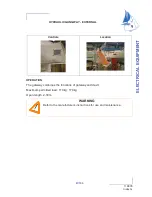
113
Trailering
Trailering the boat
WARNING
Avoid accident and injury from improper
trailering:
●
The trailer must be matched for the
boat’s weight and hull.
●
The towing vehicle must have the capac-
ity of pulling the load. Pulling a load that
exceeds the towing capacity may cause
loss of control.
●
Be sure the boat is secured to the trailer
and the trailer is properly hitched to the
towing vehicle before towing.
●
Read the manuals supplied with the
trailer by the manufacture.
A trailer is provided as standard equipment
with your boat. If you need to obtain another
trailer, choose one that is manufactured to
carry a boat of the size and weight of your
boat. Check the certification label on the left
forward side of the trailer. This label is re-
quired to show the Gross Vehicle Weight Rat-
ing (GVWR), which is the load carrying
capacity of the trailer plus the trailer’s weight.
Be sure that the total weight of your boat, any
cargo, and the trailer weight itself does not ex-
ceed the GVWR.
Hitch
The trailer hitch ball must match the size of
the socket on the trailer hitch coupler. Hitches
are divided into classes that specify the Gross
Trailer Weight (GTW) and the maximum
tongue weight. Always use a hitch rated for
the same or higher class. Use a bolted-on or
welded-on hitch; clamp-on bumper hitches
are not recommended. Be sure the trailer
hitch’s release handle is latched with the lock
pin installed before towing.
Use safety chains between the towing vehicle
and the trailer so the trailer will not detach
completely from the towing vehicle if it acci-
dentally comes loose from the hitch ball.
Crisscross the chains under the trailer tongue
so the tongue will not hit the road surface if it
falls loose. Rig the chains as tightly as possi-
ble while allowing just enough slack to permit
tight turns.
Be sure the tongue weight (vertical weight on
the hitch point) is correct. Generally, 5% to
10% of the combined weight of the boat and
trailer should be on the tongue. Too much or
too little weight can cause difficult steering or
trailer swaying.
Trailering checklist
●
Check your state laws to be sure your trailer
meets all regulations, such as proper li-
censing, brake, axle load, and safety chain
requirements.
●
Check the trailer for any loose fasteners or
damaged parts.
●
Check the tires for proper inflation.
●
Check the wheel bearings and wheel lug
nuts before each trip.
●
Check the tail, brake, and turn signal lights
for proper operation.
SportsBoat_F2J15.book Page 113 Monday, May 18, 2015 6:25 PM
















































